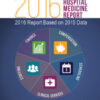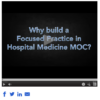2016 State of Hospital Medicine Report Now Available

The State of Hospital Medicine Report (SoHM) is the most comprehensive survey of hospital medicine in the country and provides current data on hospitalist compensation and production as well as covers practice demographics, staffing levels, staff growth, and compensation models. This year, the survey covers several new topics, including:
- The percentage of the hospital’s total patient volume (for the population the group serves, i.e., adult versus children versus both) that the hospital medicine group (HMG) was responsible for caring for
- The presence of medical hospitalists within the HMG focusing their practice on a specific medical subspecialty, such as critical care, neurology, or oncology
- The value of CME allowances for hospitalists
- The utilization of prolonged service codes by hospitalists
- Charge capture methodologies being used by HMGs
- For academic HMGs, the dollar amount of financial support provided for non-clinical work
Order your copy now and improve your practice today at www.hospitalmedicine.org/survey.



